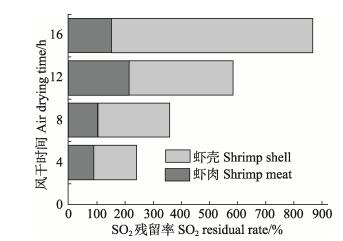2. 中国海洋大学食品科学与工程学院 青岛 266003;
3. 上海海洋大学食品学院 上海 201306
2. College of Food Science and Engineering, Ocean University of China, Qingdao 266003;
3. College of Food Science and Technology, Shanghai Ocean University, Shanghai 201306
焦亚硫酸钠因其中的SO2对虾体独特的抑黑变效果成为当前海捕虾最主要的保鲜剂(卓华龙等, 2001; 谭乐义等, 2011),目前尚无替代产品。若不使用焦亚硫酸钠等防腐剂, 每年约20%的海捕虾腐败变质, 约50%的海捕虾鲜度下降1~2个等级, 海水虾、蟹的品质与食用安全也得不到保证(Bono et al, 2012; 胡冬梅等, 2011)。SO2是一种具有多种毒性作用的全身性毒物(孟紫强等, 2001),过量的SO2进入人体后,会损害支气管和肺,进而可能诱发呼吸道炎症,并对脑、心、肝等器官有毒害作用(Bernstein et al, 2004; Ağar et al, 2000; Sunyer et al, 2003)。
近年来,虾米等虾类制品中SO2超标是我国食品质量安全抽查中屡次违禁的重点监测环节(徐慧等,2014)。2016年8月颁布的关于抗坏血酸棕榈酸酯(酶法)等食品添加剂新品种的公告中(2016年第9号),将海水虾、蟹类鲜水产品、冷冻水产品及其制品纳入食品添加剂使用标准中(中华人民共和国卫生和计划生育委员会,2014),规定焦亚硫酸钠最大使用量为100 mg/kg (以SO2残留量计),其他水产品仍不可检出。消费者购买鲜冻虾后,通常会经水煮等加工手段处理后食用,而这些加工过程对SO2残留量具有较大的影响。徐慧等(2015)研究发现,在水煮虾的过程中,去壳和淋洗可以降低虾肉中SO2残留量,目前,关于不同加工方式对海水虾及其制品中SO2脱除效果的研究较少。本研究主要探究了鲜、冻海水虾在日常家庭烹饪方式和风干过程中SO2含量的变化规律,为消费者和生产者提供有效降低鲜冻虾中SO2残留量的加工方法。
1 材料与方法 1.1 原料与试剂冻阿根廷红虾(Pleotious muelleri),规格为(60± 2) g/只;冻阿根廷红虾仁,规格为(30±2)g/只;鲜凡纳滨对虾(Litopenaeus vannamei),规格为(25±2) g/只;福临门食用调和油,均购于青岛农贸市场。
盐酸、硫酸(分析纯,莱阳经济技术开发区精细化工厂);可溶性淀粉、氢氧化钠、碳酸钠、乙酸铅、硫代硫酸钠、碘、碘化钾、亚硫酸氢钠(分析纯,国药集团化学试剂有限公司);重铬酸钾标准品(国药集团化学试剂有限公司)。
1.2 仪器与设备拜杰KF03研磨机(德清拜杰电器有限公司);阿诗顿EF410料理机(宁波阿诗顿电器有限公司);电子天平(北京赛多利斯);Miji Gala EI远红外辐射炉(米技电子电器有限公司);KQ-500DE数控超声波清洗器(昆山市超声仪器有限公司);立式低温保存箱(海尔集团);ZRD-A7080鼓风干燥箱(上海智试分析仪器制造有限公司);98-1-C型数字控温加热套(天津泰斯特仪器有限公司);蒸汽蒸馏装置;酸式滴定管。
1.3 实验方法 1.3.1 测定方法SO2 按中华人民共和国国家卫生和计划生育委员会(2016)发布的《食品安全国家标准食品中二氧化硫的测定》(GB5009.34-2016)进行测定。
水分 按中华人民共和国国家卫生和计划生育委员会等(2016)发布《食品安全国家标准食品中水分的测定》(GB5009.3-2016)的第一法进行测定。
1.3.2 感官测定参考Veli等(2008)的方法并做适当修改,邀请具有一定感官质量评定经验的5位人员组成评价小组,检验方法采用双盲法。本研究主要评定烹饪后整虾和虾仁的色泽、味道、组织状态、口感和整体可接受性,其中,每项最高分为9分,最低分为1分,根据感官评价得分来判断样品的优劣。评分标准如下:

|
先将解冻后的阿根廷红虾、虾仁以及鲜凡纳滨对虾进行分选以确保每种样品的规格基本一致,并用焦亚硫酸钠溶液预处理使样品中SO2含量达到100~120 mg/kg,模拟家庭清洗的方式,按照虾:水=1:10(m:m)的自来水量冲洗2遍。所有样品均经清洗后进行后续加工,将清洗后样品SO2残留率设为100%。
1.3.4 不同烹饪方法对整虾和虾仁中SO2含量的影响烹饪方式:(1)煮制 电磁炉加热,将5倍样品重量的水煮沸后分别放入阿根廷红虾和虾仁样品;(2)蒸制 将蒸锅内注入适量自来水置于电磁炉加热,水沸后将样品放置于蒸篦上;(3)油炸 将适量食用调和油注入常压炸锅,在温度为170℃时放入样品;(4)微波烘烤 将样品放入微波炉,以100%火力(280 W)烘烤。烹饪时长分别为2、4、6、8 min。
1.3.5 风干温度和时长对虾肉中SO2含量的影响在洁净的不锈钢锅中注入5倍于虾重量的去离子水,用电磁炉加热将水煮沸,然后将凡纳滨对虾放入锅中,火力调小保持继续沸腾,2 min后将虾取出沥水。将煮后的虾放入鼓风干燥箱中进行风干,风干温度分别为20℃、40℃、60℃、80℃;风干时长分别4、8、12、16 h。中华人民共和国农业部(2013)发布的(SC/T 3204-2012) 《虾米》对水分含量的要求为一级品≤18%、二级品、三级品≤20%,因此,当虾中水分含量低于20%则视为风干完成。
1.3.6 风干时虾壳和虾肉中SO2含量的变化情况在洁净的不锈钢锅中注入5倍于虾重量的去离子水,用电磁炉加热将水煮沸。然后将凡纳滨对虾放入锅中,火力调小保持继续沸腾,2 min后将虾取出沥水,剥离分开虾壳(含虾头)、虾肉。将虾壳、虾肉分别放入鼓风干燥箱中进行风干。风干温度为60℃;风干时长分别为4、8、12、16 h。
1.3.7 实验平行与重复所有不同处理方式均重复3次,不同重复处理样品的单一参数进行2次平行测定,取平均值为该样品测定值。
1.4 数据分析方法使用t检验和F方差齐性检验来检验虾中SO2含量在加工前后是否有显著性变化(P < 0.05为显著性差异)。采用Excel 2007和Origin Pro 9.0进行图表绘制。
2 结果与分析 2.1 不同烹饪方法对整虾和虾仁中SO2含量的影响不同烹饪方法加工后,整虾和虾仁中SO2残留率见表 1、表 2。从表 1、表 2可以看出,水煮、隔水蒸、微波烘烤和油炸4种家庭常用虾类加工方式,均能够脱除整虾和虾仁中SO2,并且随着加工时间的延长脱除效果增强。不同加工方式对整虾和虾仁中SO2脱除率有不同的影响,烹饪时间为2 min时,水煮的脱除作用最强,油炸的脱除率最小;而虾壳对虾肉中SO2的分解有保护作用,因此,不同烹饪方法中,虾仁的SO2脱除率均高于整虾。结合表 1和表 2可看出,整虾和虾仁均在水煮、隔水蒸和微波烘烤6 min时感官评分最高,油炸2 min时感官评分最高。4种加工方式对整虾中SO2的脱除率分别为水煮30.10%、隔水蒸16.30%、微波烘烤13.90%和油炸7.20%;4种加工方式对虾仁中SO2的脱除率分别为水煮55.30%、隔水蒸34.50%、微波烘烤26.80%和油炸12.10%。
|
|
表 1 不同烹饪方法加工后整虾中SO2残留率及感官评分 Table 1 The sulfur dioxide residual rate and sensory score in the whole shrimp after cooking with different methods(Mean±SD)(1) |
|
|
表 2 不同烹饪方法加工后虾仁中SO2残留率及感官评分 Table 2 The sulfur dioxide residual rate and sensory score in peeled fresh shrimp after cooking with different methods (Mean±SD) |
不同温度风干后,虾肉中的水分含量和SO2残留率见表 3。从表 3可以看出,随着风干时间的延长,SO2残留率呈先升高后降低的趋势,温度越高,SO2的分解作用越强,脱除越多。当水分含量达到20%时,20℃、40℃、60℃、80℃ 4个风干温度得到虾米成品中的SO2的残留率分别为132.00%、146.70%、78.25%、48.90%。低温风干不利于虾中SO2残留量的消除。
|
|
表 3 风干时虾肉中水分含量与SO2残留率(Mean±SD%)(1) Table 3 The moisture content and sulfur dioxide residual rate in the shrimp meat during air drying (Mean±SD, %) |
曾名勇等(1996)在研究珍味烤虾的加工工艺中认为,最佳烘烤温度为60℃干燥至水分为30%。60℃风干时,虾肉和虾壳中SO2残留率见图 1。从图 1可以看出,在60℃风干过程中,虾肉和虾壳中SO2残留量随着风干时间的延长而增加,这是因为水分的流失对SO2起到浓缩作用。虾肉中SO2残留率呈先升高后降低趋势,虾壳中的SO2残留率则一直升高。

|
图 1 60℃风干过程中虾肉和虾壳中SO2残留率 Figure 1 The sulfur dioxide residual rate in the shrimp shell and meat during air drying at 60℃ |
家庭烹饪可有效降低虾肉中SO2残留量,脱除效果从强到弱分别为水煮>隔水蒸>油炸>微波烘烤,对虾仁中SO2脱除率从12.10%~55.31%不等,罗书吉(2016)和李博雅等(2015)分别以茭白和黄花菜为研究对象,同样证实了多种方式的家庭烹饪对食品中的SO2残留量有脱除作用。但是也不能无限延长烹饪的时间,这是由于SO2不稳定,在常温下容易分解,周围温度升高和蒸汽的流动更能促进SO2挥发分解。建议消费者在烹饪海水虾时,为更好地降低SO2残留风险,最好清洗去壳后,采用水煮的方式烹饪。长时间的烹饪虽有可能达到更好脱除SO2的效果,但会损害虾肉的口感,因此,烹饪时间不宜过长,建议4种烹饪方式的时长分别为煮制、隔水蒸、微波烘烤6 min,油炸2 min。
3.2 风干温度和时间对虾肉中SO2含量的影响在风干过程中,水分的流失对虾肉中SO2首先起到浓缩作用,随着风干的进行,高温和快速的空气流动促使SO2扩散到空气中,对虾肉中SO2起到脱除作用。20℃常温风干至水分低于20%时,SO2残留率为132.00%,这是造成近年来虾米中SO2残留量超标严重的原因之一。生产者在生产过程中,应注意掌握原料虾中SO2残留情况,使收购原料符合相关标准,必要时应对原料进行SO2含量测定并选择合适的生产工艺。
3.3 烤虾加工时虾肉和虾壳中SO2含量的变化情况近年来,国家食品药品监督管理总局网站(2015)及山东省食品药品监督管理局网站(2015)发布的水产品不合格抽检信息中发现,市售烤虾中SO2残留超标情况严重。结合实验分析,主要原因如下:(1)烤虾所使用的原料多为海捕低值虾,为保鲜而添加的亚硫酸盐较多(林情员等,1999);(2)烤虾制作过程添加的砂糖、人工甜味剂、味精调味料将自身的SO2代入(曾名勇等,1996);(3)烤虾的原料虾在处理过程中只去除头和胸甲,保留尾部的虾壳,而在烤制过程中SO2极易在虾壳中浓缩。
在日常烹饪时,消费者可通过选择脱壳、水煮或适当延长烹饪时间的方式来降低海水虾中SO2的残留量;海水虾制品生产企业需要全面、系统地分析原料中SO2残留情况,适当的选择加工工艺,使之既能保持良好的感官风味,又能有效降低成品中SO2残留超标的安全风险。
| Ağar A, Kü ükatay V, Yargi oğlu P, et al. The effect of sulfur dioxide inhalation on visual evoked potentials, antioxidant status, and lipid peroxidation in alloxan-induced diabetic rats. Archives of Environmental Contamination and Toxicology, 2000, 39(2): 257-264 DOI:10.1007/s002440010103 | |
| Bernstein J, Alexis N, Bacchus H, et al. The health effects of non-industrial indoor air pollution. Journal of Allergy and Clinical Immunology, 2008, 121(3): 585 DOI:10.1016/j.jaci.2007.10.045 | |
| Bono G, Badalucco CV, Cusumano S, et al. Toward shrimp without chemical additives: A combined freezing-MAP approach. Food Science Technology, 2012, 46(1): 274-279 | |
| China Food and Drug Administation. http://www.sda.gov.cn/WS01/CL0050/130741.html [关于89批次不合格食品情况的通告(2015年第68号)] | |
| Hu DM, Sun T, Xie J. Research progress on Penaeus vannamei preservation. Food Science, 2011, 32(13): 365-368 [胡冬梅, 孙涛, 谢晶. 南美白对虾保鲜剂研究进展. 食品科学, 2011, 32(13): 365-368] | |
| Li BY, Zhou X, Dai YQ, et al. Processing effects of the sulfur dioxide content on day lily. Food Science and Technology,, 2015(5): 110-113 [李博雅, 周忻, 戴蕴青, 等. 加工对黄花菜中二氧化硫含量的影响. 食品科技, 2015(5): 110-113] | |
| Lin QY, Hong J. Study on processing technology for grilled shrimp of which catching from sea with low value. China Fisheries, 1999(11): 48-49 [林情员, 洪江. 利用海捕低值虾类加工珍味烤虾的工艺研究. 中国水产, 1999(11): 48-49] | |
| Luo SJ. Study on effect of processing on sulfur dioxide residues and dietary exposure assessment in Zizania latifolia. Master's Thesis of Hainan University, 2016 [罗书吉. 加工方式对茭白中二氧化硫残留的影响及其膳食暴露评估. 海南大学硕士研究生学位论文, 2016] | |
| Lv HX, Cai F, Zou LF, et al. The effect of different cuisine ways and time on the nitrite content in dried small shrimps. Modem Preventive Medicine, 2014, 41(9): 1576-1578 [吕鸿鑫, 蔡奋, 邹立芬, 等. 烹饪方式与时间对虾皮亚硝酸盐含量的影响. 现代预防医学, 2014, 41(9): 1576-1578] | |
| Meng ZQ, Zhang B, Qin GH. Oxidation damage of sulfur dioxide on various organs of mice. Acta Scientiae Circumstantia, 2001, 21(6): 769-773 [孟紫强, 张波, 秦国华. 二氧化硫对小鼠不同组织器官的氧化损伤作用. 环境科学学报, 2001, 21(6): 769-773] | |
| Ministry of Agriculture of the People's Republic of China. People's Republic of China aquatic industry standard. Dried peeled shrimp(SC/T3204-2012). 2013 [中华人民共和国农业部. 中华人民共和国水产品行业标准. 虾米(SC/T3204-2012). 2013] | |
| National Health and Family Planning Commission of the People's Republic of China (GB5009. 34-2016). 2017 [中华人民共和国国家卫生和计划生育委员会. 食品安全国家标准食品中二氧化硫的测定(GB 5009. 34–2016). 2017] | |
| National Health and Family Planning Commission of the People's Republic of China. Standard for uses of food additives (GB2760-2016). 2016 [中华人民共和国国家卫生和计划生育委员会. 食品添加剂使用标准(GB 2760–2014), 2015] | |
| National Health and Family Planning Commission of the People's Republic of China, Standardization Administration of the People's Republic of China. Determination of moisture in foods (GB5009. 3-2016). 2016 [中华人民共和国国家卫生和计划生育委员会, 中国国家标准化管理委员会. 食品中水分的测定(GB5009. 3-2016). 2016] | |
| National Health and Family Plannmg Commisson of the Peope's Republic of China. Supplementary notice about new food additives such as ascorbyl palmitate (enzymatic). http://www.nhfpc.gov.cn/sps/s7890/201608/f06b07409beb4b798fb51e0f3042f99f.shtml. 2016-08-03 [中华人民共和国卫生和计划生育委员会. 关于抗坏血酸棕榈酸酯(酶法)等食品添加剂新品种的公告. http://www.nhfpc.gov.cn/sps/s7890/201608/f06b07409beb4b798fb51e0f3042f99f.shtml. 2016-08-03] | |
| Shandong Food and Drug Administation. http://www.sdfda.gov.cn/art/2015/6/2/art_1323_63682.html, 2016(6) [山东省食品安全监督抽检信息公告. http://www.sdfda.gov.cn/art/2015/6/2/art_1323_63682.html, 2016(6)] | |
| Sunyer J, Ballester F, Tertre AL, et al. The association of daily sulfur dioxide air pollution levels with hospital admissions for cardiovascular diseases in Europe (The Aphea-Ⅱ study). European Heart Journal, 2003, 24(8): 752-760 DOI:10.1016/S0195-668X(02)00808-4 | |
| Tan LY, Gong F, Lin LM, et al. Sulfite preservatives in shrimp preservation research. International symposium on technology and food safety standards AOAC Chinese conference proceedings, 2011, 104–108 [谭乐义, 龚方, 林黎明, 等. 亚硫酸盐保鲜剂在对虾保鲜中的应用研究. 食品安全技术与标准国际研讨会暨AOAC中国区会议论文集, 2011, 104–108] | |
| Veli G, Ersel O, Levent A. Effects of packaging method and storage time on the chemical, microbiological, and sensory properties of Turkish pastirma—A dry cured beef product. Meat Science, 2008, 80(2): 335-344 DOI:10.1016/j.meatsci.2007.12.017 | |
| Xu H, Cheng YX, Zheng ZH, et al. Detection result and analysis of sulfur dioxide residue in shrimp. Scientific Fish Farming, 2014(9): 50 [徐慧, 程岩雄, 郑赵红, 等. 海水虾二氧化硫残留量检测结果分析. 科学养鱼, 2014(9): 50] | |
| Xu H, Cheng YX, Zheng ZH, et al. Study on comparison of sulfur dioxide residues in shrimp after different pretreaments. Food Research and Development, 2015, 36(13): 20-22 DOI:10.3969/j.issn.1005-6521.2015.13.006 [徐慧, 程岩雄, 郑赵红, 等. 不同预处理后海水虾二氧化硫残留量比较的研究. 食品研究与开发, 2015, 36(13): 20-22] | |
| Zeng MY, Qin PH. Processing technology for Foasted shrimp. Fishery Modernization, 1996(5): 18-19 [曾名勇, 秦培华. 珍味烤虾的加工工艺. 渔业现代化, 1996(5): 18-19] | |
| Zhuo HL, Liu H, Shentu JK, et al. Comparison of effect of 4 fresh-tress-preserving agents and 3 methods of application on preservation of sea prawn. Chinese Journal Food Hygiene, 2007, 19(3): 228-233 [卓华龙, 柳海, 申屠基康, 等. 海水虾保鲜效果的比较. 中国食品卫生杂志, 2007, 19(3): 228-233] |



